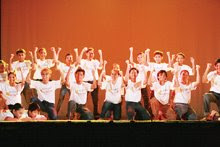Deaf performers bring awareness to the Philippines

From
The Manila Times:
The whole theater thumped with life as the music bounced off the walls, waking up the souls that dared to succumb to the late night calls of sleep. The dancers were just as alive, their shiny white smiles blending well with the colors of the shimmering lights. Kids, teenagers, and the 20-somethings grooved endlessly like there was nothing unusual, like they weren’t different from the rest of humanity.
But all they were hearing was a blank, white noise. Nothing of the thumping music, of the noisy applause, and the shuffling of feet because while they could see everything within their periphery, these kids barely hear what the commotion was all about—some even are completely deaf, the noise completely blanketed out from their system.
Deafness is characteristically defined as the lack, or the absence of the sense of hearing. For most people, being hard of hearing is a handicap and creates a barrier for full and comprehensive communication, leaving the hearing-impaired within the shadows of incapability. But during the successful staging of the Rhythm Within on June 11 at the AFP Theater, the children with hearing problem proved that they were never lacking, nor were they wanting, and that they can do what normal hearing persons can do.
The Rhythm Within (pictured) tore down the harsh walls of communication barriers between the normal hearing person and the hearing-impaired, having been organized as a dance musical performance by some 25 student-scholars. It is the third of a series of successful performances by the student-scholars of the LINK Center for the Deaf, in cooperation with the Quezon City Performing Arts helmed by Luther Perez, and under the direction of the late dance master Tony Fabella.
“For most of them performing tonight, they may have never known what music sounds like. But most of us, deaf people would also want to be heard,” Carolyn Ui, president of the LINK Center for the Deaf said during the night of dancing and overwhelming performance. “Allow yourselves to listen to their voices and as you listen with your eyes and hearts, I hope you manage to catch what they have to say.”
Founded in 2002 by sisters Carolyn and Marical Ui, LINK Center for the Deaf is a “service-oriented organization that provides support programs and promotes awareness of deaf individuals to the mainstream society,” that creates avenues for interaction, creativity and awareness for both the hearing and the non-hearing sides.
“In 2000, we had the chance to head the National Celebration of Deaf Awareness and that was when we got exposed to the plight of the deaf children in the public schools,” Carolyn explained. “So on April 1, 2002, we started the center, and seven years later, we were already very much in public schools, not only in NCR but as well as the whole of Visayas and Luzon.”
Having been exposed early on to the deaf community through an uncle who worked at Miriam College-Southeast Asian Institute for the Deaf and a cousin who was deaf, the Ui sisters never gave much thought about any other career despite having finished Business Administration. The sisters, however, weren’t prepared for the lamentable situation of the kids with hearing problems in public schools.
“There was a school that had at least 70 deaf students from Grades 1 to 6 with only one sign teacher,” Carolyn shared. “Can you imagine what kind of communication they do? You have a teacher talking in front but no one signing! So what happens to the deaf? The deaf sits there—not hearing anything, only looking at the board, reading, copying, but they weren’t learning. You’re in school, but you’re not learning.”
“Often, these students can be found in makeshift classrooms,” Marical added.
The discrepancies between a private and a public school are magnified by the basic education curriculum, where most private schools can accommodate any disabled student through the Special Education (SPED) program—an education component completely lacking in public schools.
“Regular hearing students in public schools lack in materials—what more with the deaf? They always find themselves the last recipients of learning materials,” Carolyn lamented. “The deaf always becomes the teacher’s helper—to bring the trays back to the cafeterias, for example.”
It was from these situations that the Ui sisters found a central mission and corresponding solutions through their various programs which included the “Breaking Barriers, Building Bridges” project. Funded by the Deaf Children Worldwide, it consists of visual and performing arts that aim to enhance the public awareness on the education and training of the hearing impaired, to recognize that the only thing they cannot do is hear, and to encourage the public to look beyond the hearing loss and to consider possible options such as education and employment for them.
Often, according to the Ui sisters, the hearing impaired are among the marginalized, with many employers refusing to look beyond the incapability, where, in fact, the non-hearing group has the same potentials as any other person.
But LINK, with a huge amount of selflessness, effort, compassion and hard work, has successfully minimized the gap between these two worlds, inspiring the hearing impaired to be better and urging the hearing persons to look beyond what they consider to be a handicap.
 From The Manila Times:
From The Manila Times: